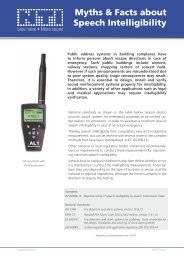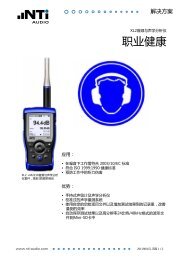Appnote
Appnote
Appnote
You also want an ePaper? Increase the reach of your titles
YUMPU automatically turns print PDFs into web optimized ePapers that Google loves.
AppNote<br />
S/PDIF<br />
Sony / Philips Digital Interface<br />
The S/PDIF interface was developed by Sony and Philips for semi<br />
professional and consumer purposes. Later it was standardised by the IEC<br />
under the official name IEC-60958 Type II.<br />
Specifications<br />
Electrical connection<br />
This interface enables a cost effective way to connect all types of<br />
consumer products as CD players, PC soundcards, DVD players or<br />
others that provide this digital audio interface. The S/PDIF interface<br />
is much the same as the AES3 interface. It adopts the identical<br />
frame structure and coding rules as AES3.<br />
The differences are these:<br />
Transmission takes place via short unbalanced cables or short optical<br />
fibres. Channel status information are specific for consumer<br />
applications. Only sample frequencies up to 48kHz are specified.<br />
• protocol identical with AES3<br />
• 2 channel transmission (as AES3)<br />
• audio data up to 24Bit / 48kHz<br />
• unbalanced cable<br />
• cinch connector<br />
• cable length: max. 1m<br />
• impedance 75Ohm (± 20%)<br />
• levels: 200 500 mVpp (at 75Ohm)<br />
S/PDIF Page 1 V1.0, Feb. 06
Optical connections<br />
How the SCMS works<br />
• optical fiber made from inexpensive plastic<br />
• TOSLINK connectors<br />
• cable length: 3m up to 10m (depending on quality of compo<br />
nents; cable lengths are not specified within the standard)<br />
The copy protection possibility when running the AES3 interface in<br />
consumer mode was already mentioned above in brief. The protection<br />
will disable copying of a digital audio data stream in more<br />
than one generation. This means: for backup purposes one copy<br />
of copyrighted audio material is allowed. But from this copy no<br />
further copy can be made. The method of copy protection applied<br />
here is called SCMS (Serial Copy Management System) and it works<br />
as follows:<br />
Consumer channel status Bits 2 and 15 pertain to this matter. Aside<br />
other status information as sample frequency, sample resolution<br />
emphasis etc. is available. Bit 15 is called the L-bit. Bit 2 decides if<br />
copyright is asserted to the audio material.<br />
The L-bit signifies the generation of the audio material. An digital<br />
audio stream with L-bit set ´1´ comes from the original and not<br />
from a copy. When copying this data stream the L-bit is set to ´0´.<br />
A data stream from this copy can’t be copied.<br />
Strangely enough the signification of the L-bit is just reverse for<br />
CD players (0 = Original, 1 = copy). Perhaps this is by historical<br />
reasons.<br />
S/PDIF Page 2 V1.0, Feb. 06
Cable<br />
Figure:<br />
The somewhat obscured Serial Copy Management information<br />
represented in an evident manner by NTI’s digital audio analyzer<br />
DL1. The figure shows a not copied signal (generation ORIGINAL)<br />
with no copyright asserted.<br />
Impedance of cables proper for S/PDIF is 75 Ohm. This is just the<br />
same impedance as common with video. So video cable with cinch<br />
connectors is very suitable.<br />
S/PDIF Page 3 V1.0, Feb. 06
















